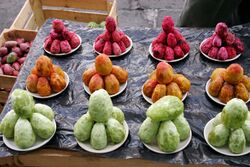Biology:List of edible cacti
From HandWiki
Short description: None
This is a list[1] of edible plants in the family Cactaceae.
- Acanthocereus tetragonus, the sword pear,
- Browningia candelaris,[2]
- Carnegiea gigantea, the Saguaro,
- Cereus repandus - California and Florida
- genus Corryocactus (also known as Erdisia), the tasty berrylike
- C. brevistylis, C. pulquiensis, and C. erectus
- Coryphantha
- C. robbinsorum and C. recurvata.
- genus Echinocereus ("Strawberry Cactus")
- E. engelmannii, E. bonkerae, E. boyce-thompsonii
- E. enneacanthus, E. cincerascens, E. stramineus
- E. dasyacanthus, E. fendleri and E. fasciculatus
- E. brandegeei, E. ledingii and E. nicholii
- E. engelmannii ("Strawberry Vanilla")
- genus Echinopsis
- South American species
- E. (or T.) atacamensis, E./T. coquimbana and E./T. schickendanzii
- South American species
- genus Epiphyllum, the Orchid cactus
- E. anguliger (also called Phyllocactus darrahii, said to be like gooseberries)
- genus Epithelantha (the fruit of all species said to be edible)
- genus Eulychnia
- E. acida
- genus Ferocactus
- Ferocactus hamatacanthus
- F. histrix ("borrachitos") and F. latispinus ("pochas")
- genus Harrisia (of Florida and the Caribbean), the "Prickly Apples"
- NOTE: The following 5 are said to be "endangered endemic" :
- H. aboriginum, H.simpsonii, H. adscendens, H fragrans and H. eriophora
- H. pomanensis
- Argentinian H. balansae
- genus Mammillaria ("chilitos" as they look like tiny red chili peppers)
- M. applanata, M. meiacantha, M. macdougalii, M. lasiacantha
- M. grahamii, M. oliviae, M. mainiae, M. microcarpa, M. thornberi and many others
- Maihuenia
- Myrtillocactus geometrizans ("garambulos", taste like less-acid cranberries)
- Neowerdermannia vorwerkii , the achakana
- genus Opuntia, the prickly pears
- genus Pachycereus,
- Pachycereus pringlei, the Cardon
- P. schottii, the Senita and P. weberi, the Candelabro
- genus Peniocereus,
- Peniocereus greggii, the Arizona Queen of the Night
- P. johnstonii and P. serpentinus
- genus Pereskia
- P. aculeata, the "Barbados gooseberry"
- P. guamacho
- Genus Selenicereus
- S. undatus, S. megalanthus and other species ("dragon fruits")
- genus Stenocereus (quite sweet, but prone to ferment; hence the "agria" [="sour"]))
- S. fricii ("Pitayo de aguas"), S. griseus ("Pitayo de Mayo"), S. gummosus ("Pitahaya agria")
- S. pruinosus ("Pitayo de Octubre"), S. montanus ("Pitaya colorada")
- S. queretaroensis ("Pitaya de Queretaro"), S. standleyi ("Pita Marismena"), S. stellatus ("Xoconostle")
- S. thurberi ("Organ Pipe Cactus", "Pitayo Dulce") and S. treleasi ("Tunillo")
References
- ↑ Marmaro, John P. "What cacti produce edible fruit or are edible?". http://forums.gardenweb.com/discussions/1801124/what-cacti-produce-edible-fruit-or-are-edible.
- ↑ Anderson, Edward F. (2001), The Cactus Family, Pentland, Oregon: Timber Press, ISBN 978-0-88192-498-5, p. 134
- ↑ "Harrisia Cactus". http://herbiguide.com.au/Descriptions/hg_Harrisia_Cactus.htm. Retrieved 23 February 2017.
- ↑ Kershaw, MacKinnon, Pojar (1998). Plants of the Rocky Mountains. Lone Pine Publishing. p. 181. ISBN 1-55105-088-9.
- ↑ "Cahuilla Plants". http://www.enduringknowledgepublications.com/cahuillaplants.html.
- ↑ "Temalpakh Ethnobotanical Garden". http://www.malkimuseum.org/garden.htm.
 |



